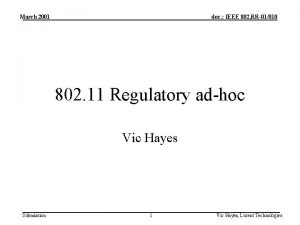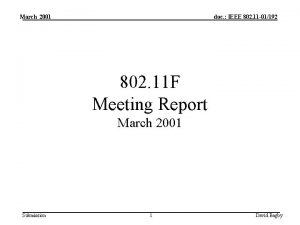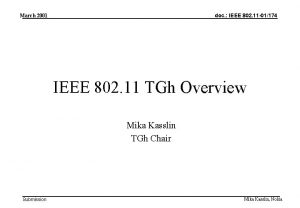March 2001 doc IEEE 802 15 01173 r





- Slides: 5

March 2001 doc. : IEEE 802. 15 -01/173 r 0 IEEE P 802. 15 Working Group for Wireless Personal Area Networks. TM Request for TG 3 PHY and MAC Models for Incorporation into TG 2 Coexistence Model Submission 1 Steve Shellhammer, Symbol Technologies

March 2001 doc. : IEEE 802. 15 -01/173 r 0 Importance of Coexistence • It is critical that 802. 15. 3 coexist well with other 802 wireless standards – 802. 11 b – 802. 15. 1 • The first step to ensure coexistence is incorporation of a TG 3 PHY/MAC model into the TG 2 Coexistence Model Submission 2 Steve Shellhammer, Symbol Technologies

March 2001 doc. : IEEE 802. 15 -01/173 r 0 Required Models • To support TG 3 we need the following models – A PHY level model of TG 3 transmitter and receiver. This should be a baseband equivalent model (C-code or Mat. Lab). – A MAC level model of TG 3 in Opnet. – TG 3 data traffic models. – A TG 3 Channel Model Submission 3 Steve Shellhammer, Symbol Technologies

March 2001 doc. : IEEE 802. 15 -01/173 r 0 Contacts within 802. 15. 2 • PHY Layer Model & Channel Model – Robert Van Dyck • MAC Layer Model & Data Traffic Model – Nada Golmie Submission 4 Steve Shellhammer, Symbol Technologies

March 2001 doc. : IEEE 802. 15 -01/173 r 0 Coexistence Model • Once TG 2 receives the TG 3 models we will incorporate those models into the Coexistence Model • We will then run scenarios to investigate the effects of the mutual interference with other wireless systems – 802. 15. 1 (Bluetooth) – 802. 11 b Submission 5 Steve Shellhammer, Symbol Technologies








